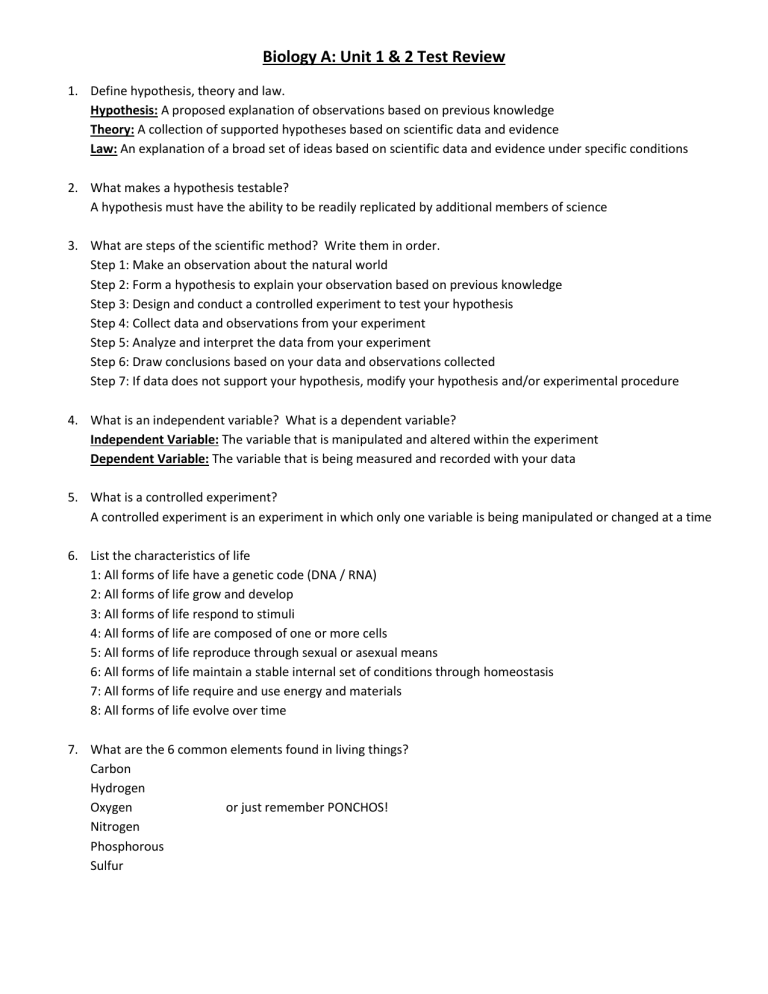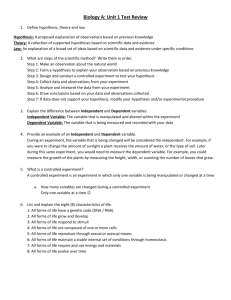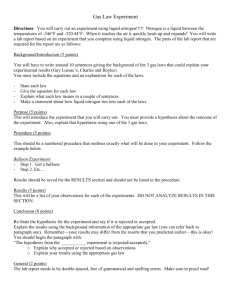File

Biology A: Unit 1 & 2 Test Review
1.
Define hypothesis, theory and law.
Hypothesis: A proposed explanation of observations based on previous knowledge
Theory: A collection of supported hypotheses based on scientific data and evidence
Law: An explanation of a broad set of ideas based on scientific data and evidence under specific conditions
2.
What makes a hypothesis testable?
A hypothesis must have the ability to be readily replicated by additional members of science
3.
What are steps of the scientific method? Write them in order.
Step 1: Make an observation about the natural world
Step 2: Form a hypothesis to explain your observation based on previous knowledge
Step 3: Design and conduct a controlled experiment to test your hypothesis
Step 4: Collect data and observations from your experiment
Step 5: Analyze and interpret the data from your experiment
Step 6: Draw conclusions based on your data and observations collected
Step 7: If data does not support your hypothesis, modify your hypothesis and/or experimental procedure
4.
What is an independent variable? What is a dependent variable?
Independent Variable: The variable that is manipulated and altered within the experiment
Dependent Variable: The variable that is being measured and recorded with your data
5.
What is a controlled experiment?
A controlled experiment is an experiment in which only one variable is being manipulated or changed at a time
6.
List the characteristics of life
1: All forms of life have a genetic code (DNA / RNA)
2: All forms of life grow and develop
3: All forms of life respond to stimuli
4: All forms of life are composed of one or more cells
5: All forms of life reproduce through sexual or asexual means
6: All forms of life maintain a stable internal set of conditions through homeostasis
7: All forms of life require and use energy and materials
8: All forms of life evolve over time
7.
What are the 6 common elements found in living things?
Carbon
Hydrogen
Oxygen
Nitrogen
Phosphorous
Sulfur or just remember PONCHOS!
8.
Fill in the following chart. What are the 3 subatomic particles? What is the charge of each? Where are they located?
Sub-atomic particle
Protons
Neutrons
Electrons
Charge
Positive
Neutral
Negative
Location
Nucleus of atom
Nucleus of atom
Electron cloud outside nucleus of atom
9.
Explain the following properties of water in your own words: a.
Cohesion – The tendency of molecules to “stick” to similar molecules; water sticking to water b.
Adhesion – The tendency of molecules to “stick” to different molecules; water sticking to a glass c.
Surface tension – The force created by water molecules between the surface of water and the air above
10.
Fill in the blank with the term that describes the following pH ranges. a.
pH 0-6: Acidic b.
pH 7: Neutral c.
pH 8-14: Basic
11.
Why is carbon important to living things? List at least 3 characteristics that we discussed in class.
Carbon can have four bonds
Carbon can form long carbon-to-carbon chains
Carbon can form ring structures
12.
Which type of macromolecule are enzymes?
13.
How do enzymes affect a reaction?
Enzymes speed up chemical reactions
Enzymes are classified as a type of protein
14.
Fill out the macromolecule graphic organizer on the next page.
What it’s
made up of
Common
Names
Carbohydrate
Monosaccharides
Sugar, starch, fiber
Lipid
Protein
Nucleic Acid
Fatty acids & glycerol
Amino Acids
Phosphate, sugar, nitrogen base
Fats & oils
Proteins
DNA / RNA
Composed of
___Elements
Carbon,
Hydrogen,
Oxygen
Carbon,
Hydrogen,
Oxygen
Carbon,
Hydrogen,
Oxygen,
Nitrogen
Carbon,
Hydrogen,
Oxygen,
Nitrogen,
Phosphorous,
Sulfur
Function in
Organism
Short-term energy storage
Long-term, energy storage, cell membrane, chemical signals
Workers of the body
Stores all genetic information









